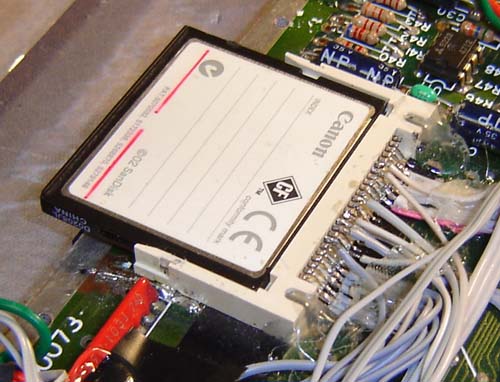|
|
|||||
"Making Of" Story For many years an Atari 800 laptop was my "dream portable". Then after I built it I had no more worlds to conquer, so to speak. Well, I do, my custom pinball machine, but I digress. Anyway, earlier this year I had a request to build another Atari 800 laptop so I decided to have another whack at it. With less woodgrain this time, and hopefully some new features. I also wanted to redo the keyboard design. As with the previous laptop I began with an Atari XEGS, the GS meaning "Game System", or "Gone Soon" considering how they sold. Still, it's the last model Atari 800 class computer and thus has the smallest motherboard. Why exactly Atari thought a 1979 era computer, disgusted as a game system, could compete with the NES or the Master System is beyond me. Yes, I know the NES/Master System weren't exactly technological wonders but they easily beat the 800 for graphics, I'm sad to say. f Using Mr. Atari's MyIDE interface yet again (since it's awesome) I wired up the motherboard. Oh yes I guess I should explain what the MyIDE is. It's a custom OS ROM and some support circuitry that allows you to attach an IDE hard drive to an Atari computer and use it as a large, fast disk drive. CompactFlash works too since it's pin compatible with IDE. Check out his site! (opens in new window) Notice below how I kept things much flatter than before - it kind of pained me with the last laptop that in 2005 I was working with a lot of soldering I did in 2003, when I started the project. That's the one good thing about getting older, you only get better at [most] things.
Since then I have also learned more about CompactFlash cards, specifically that the wire up just like an IDE hard drive. Thus, an "IDE to CompactFlash" adapter is pointless. So I wired everything directly to a CompactFlash slot, as shown below. Coincidently, this slot came off the TV I used for the last Atari laptop.
This time I stuck in a cartridge slot, though it was kind of a pain to do and made me realize why I didn't the first time. I used, well, most of an IDE cable and wired it on the bottom of the motherboard. This is on the opposite side of the CompactFlash. The thinner the better.
With the base electronics out of the way I started on the case. While this looks similar to the original laptop it's actually an all-new design. The thickness remains the same, one and a half inches. Here's the inside of the new style keyboard. The keys are all flat on the surface but unlike a membrane keyboard they actually push in and have a "click". Each key is a round piece with 2 layers, with a square hole in the second layer. This hole allows the small tact switch to fit inside and make the keyboard, yes here comes the word again, thinner.
Here's a close-up of the keys in the finished unit. They were laser engraved in a raster fashion, allowing fine detail. The built-in flat joypads were done in a similar manner, but a little more raised over the surface than the keys.
Here's the hand wired back of the keyboard matrix. I did this faster than the first version, but it's still tricky. This is a good example of why my mods have a bit of cost to them. I also made the "auto cursor" disc again - you can press this in a direction to move the cursor around the screen. Typically in old computers, like the Atari, you had to press control+arrow keys to do this.
Another large portion was the screen frame. It includes all shiny chrome and black graphics and the famous built-in "error list" Not that anything would EVER go wrong with an Atari! It also includes the screen control buttons and some silver mesh for the speakers. An Atari 800 is in mono but that doesn't mean I can't through in 2 speakers and pipe the same thing to both. Besides, it looks more symmetrical this way.
Here's all the main case parts laid out and ready for stuffing, much like a turkey.
This unit uses the same type of screen as the original laptop, though Radio Shack stopped selling them and I had to find one off eBay. This time I used the hinge from the screen for the resulting laptop itself, though I wish I would have used 2 hinges instead of one.
The next step is to start putting the electronics inside this case, which obviously warrants a second webpage... NEXT
- Shoving the components into the case...
|
|||||









